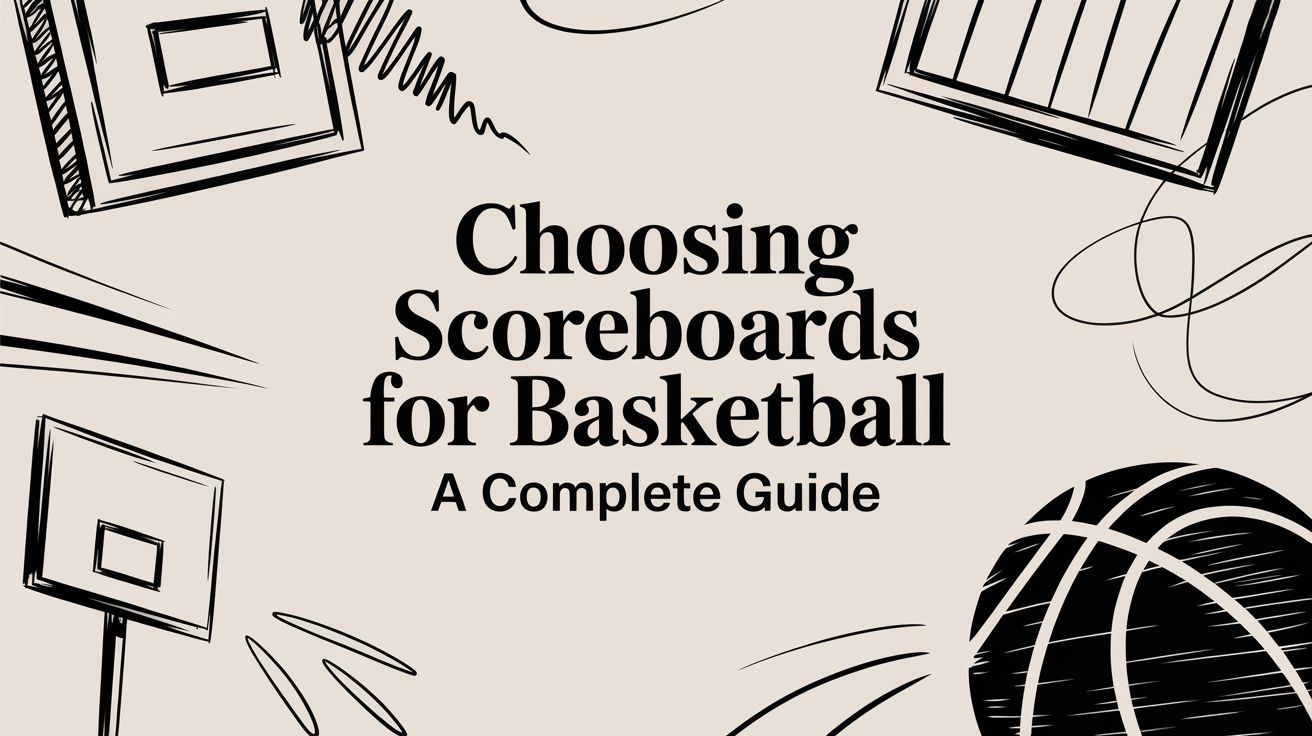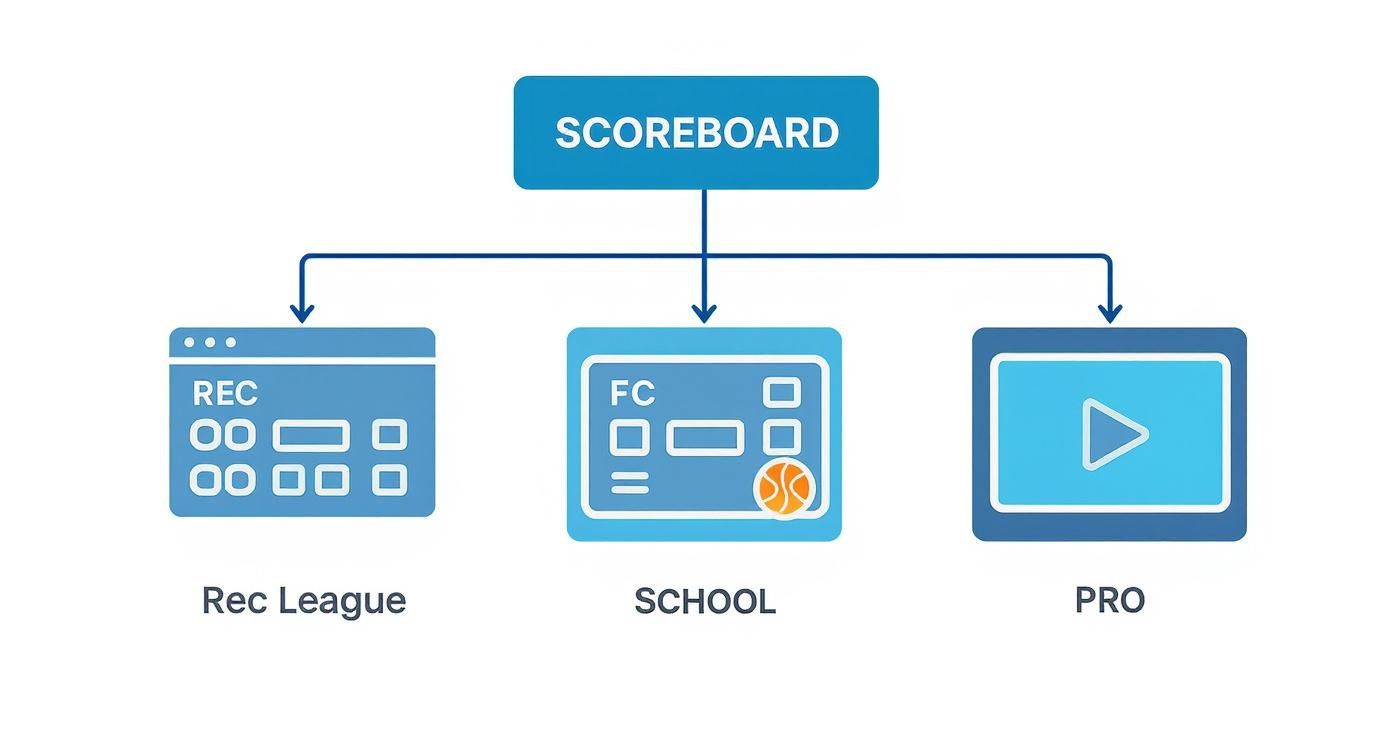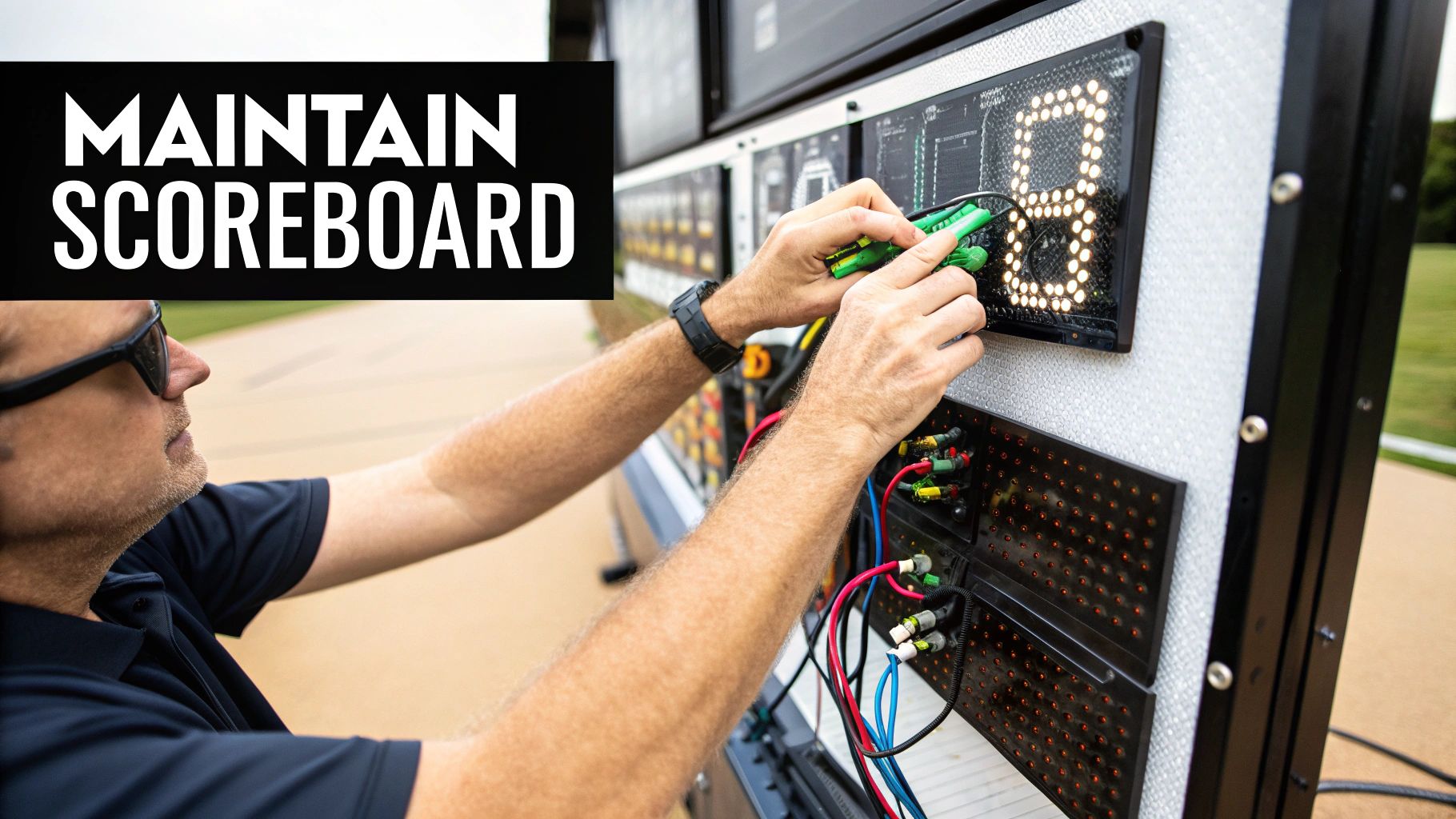
Choosing Scoreboards for Basketball A Complete Guide
A modern basketball scoreboard is so much more than a device for tracking numbers; it's the central nervous system of the entire game-day experience. It’s

A modern basketball scoreboard is so much more than a device for tracking numbers; it's the central nervous system of the entire game-day experience. It’s the one piece of equipment that connects the players, the coaches, and every single fan in the stands. This guide is designed to cut through the confusing technical jargon and give you a clear, practical roadmap for choosing the perfect scoreboard for your needs.
Think of a basketball scoreboard not just as a piece of hardware, but as a storyteller. It narrates the game's tension, celebrates its biggest moments, and dictates its pace. From the opening tip-off to the final, heart-stopping buzzer-beater, it commands everyone's attention and completely shapes the atmosphere of the event. A great scoreboard can transform a simple gym into an electrifying arena, creating memories that last a lifetime.
It wasn't always this way. Historically, keeping score was a manual chore. The earliest scoreboards, believe it or not, were used in ancient Greek and Roman athletics, where operators had to physically change numbers by hand. This journey from simple flip cards to the dynamic digital hubs we see today represents a massive shift in how we experience live sports.
Today's basketball scoreboards are powerful communication platforms that go far beyond the basics. They serve multiple functions that can elevate your venue and engage your audience on a much deeper level.
The right scoreboard doesn't just display information; it creates an environment. It’s the difference between simply hosting a game and creating a true sporting spectacle that people will remember and talk about long after they leave.
Ultimately, investing in the right scoreboard is an investment in your entire program. The technology that powers these displays often overlaps with other high-impact visual solutions. In fact, many of the principles that make a great scoreboard also apply to the benefits of LED signs for businesses.
Choosing the right basketball scoreboard really starts with two simple questions: where will it live, and who is it for? You wouldn't put your living room TV out on the patio, and for the same reason, you can’t just stick a standard indoor scoreboard in an outdoor park. They’re engineered for completely different worlds.
An outdoor scoreboard is built like an all-terrain vehicle. It has to be tough enough to handle rain, snow, and brutal temperature swings. Its casing needs a high Ingress Protection (IP) rating—a fancy term for how well it’s sealed against dust and moisture. But most importantly, its display has to be incredibly bright to cut through the glare of direct sunlight. An indoor model would lose that battle instantly.
On the other hand, an indoor scoreboard is more like a cinema screen. It doesn’t need all that heavy-duty weatherproofing, but its success is all about giving a captive audience the perfect view. Engineers focus on wide viewing angles so the fans way up in the cheap seats see the same crisp, clear numbers as the folks at center court.
Beyond just indoor versus outdoor, the level of play completely changes what you need from a scoreboard. A board for a casual church league has totally different requirements than one for a D-I college championship. It’s all about matching the tech to the complexity of the game on the court.
For a recreational or youth league, simple is almost always better. The main job is to show the essentials without overwhelming volunteer scorekeepers or distracting the kids.
Once you get to the high school level, things get more serious. The competition is more intense, the rules are more complex, and the fan experience actually starts to matter. The scoreboards for basketball here need to tell more of the story.
This decision tree infographic helps show how scoreboard needs grow right alongside the level of competition.

As you can see, the jump from a simple rec league setup to a professional display is all about adding layers of critical game data.
A standard high school scoreboard has to show more than just points and time. It needs to track team fouls, which is crucial for knowing when a team is in the "bonus" and starts shooting free throws. A built-in shot clock also becomes a must-have, as most high school athletic associations require one to keep the game moving.
A high school scoreboard isn’t just a convenience; it's the official record-keeper. Its accuracy and the information it provides directly impact game strategy, officiating, and the legitimacy of the entire event.
At the highest levels of basketball, the scoreboard stops being just an informational tool and becomes a central part of the show. It’s not just about displaying game data anymore; it’s about creating an electrifying atmosphere for thousands of fans—and, let's be honest, generating revenue.
These high-end systems are full-blown multimedia hubs.
By figuring out exactly where your facility fits on this spectrum—from a community park to a major arena—you can zero in on the features you actually need and avoid wasting your budget on a system that’s total overkill.
Stepping into the world of basketball scoreboards can feel like you're trying to learn a new language. You'll hear terms like "pixel pitch," "fixed-digit," and "wireless connectivity" thrown around, but what do they actually mean for your game-day experience? Let's cut through the jargon and talk about the features that truly matter.
At the heart of any modern scoreboard is its display. The days of those old, clunky light bulb displays are long gone. Today, it’s all about Light Emitting Diode (LED) technology, a shift that completely changed the game.
LEDs turned scoreboards from simple number-keepers into full-blown multimedia systems that can show everything from crisp HD video to detailed game stats. The jump from incandescent bulbs to LEDs was massive—they use way less power, don't get nearly as hot, and can display a whole spectrum of colors. If you want to see just how far we've come, check out this great piece on the evolution of electronic scoreboards.
The most important job of a scoreboard is to be readable. Period. Two key factors determine how sharp and clear everything looks to your fans: digit type and pixel pitch.
H3: Fixed-Digit vs. Video Displays
Think of it like the difference between a classic digital watch and a modern smartwatch. Both tell time, but they do it in very different ways.
For video displays, pixel pitch is the spec you’ll hear about most. It’s simply the distance, in millimeters, between the center of one pixel and the center of the next.
Analogy: Think of pixel pitch like the thread count on a set of bedsheets. A lower number means the pixels are packed tighter, creating a smoother, higher-resolution image—just like a higher thread count creates softer, more luxurious fabric.
A small pixel pitch like 4mm is perfect for indoor arenas where fans are sitting closer to the screen. For a huge outdoor stadium where the viewing distance is much greater, a larger pitch like 10mm will look just as good and be more cost-effective.
No matter how fancy the tech gets, every basketball scoreboard has to nail the essentials. These are the non-negotiables that officials, players, and fans depend on from tip-off to the final buzzer.
Beyond these, even basic scoreboards usually include a spot for timeouts remaining—a must-have for coaches plotting their late-game strategy.
For colleges, pro arenas, or any high school looking to create a top-tier atmosphere, advanced features turn the scoreboard into the main event. These options go way beyond just keeping time and score.
To make sense of it all, it helps to see what separates a standard setup from a professional one.
| Feature | Essential (High School & Rec Leagues) | Advanced (College & Pro Venues) |
|---|---|---|
| Basic Info | Score, Time, Period, Fouls | All essentials plus integrated real-time stats |
| Player Stats | Not typically available | Displays individual points, fouls, and rebounds |
| Media Display | Static sponsor panels | Full-motion video ads and instant replays |
| Customization | Basic team name labels | Dynamic team names, logos, and animations |
| Interactivity | None | Fan engagement features like the "Kiss Cam" or social media feeds |
As you can see, the jump from essential to advanced is all about creating a richer, more immersive experience that not only wows the crowd but can also generate revenue through advertising and sponsorships.
Finally, you need to think about how you'll actually run the thing. The connection between your controller and the scoreboard is a crucial detail that impacts both setup and daily operation.
H3: Wired Systems
This is the old-school, tried-and-true method. A physical cable connects the operator's console directly to the scoreboard. It’s incredibly reliable and completely immune to radio interference, which makes it a safe bet for most permanent indoor installations where you can run the cable once and forget about it.
H3: Wireless Systems
Using radio frequency (RF) signals to communicate, wireless systems offer amazing flexibility. The operator can control the board from a tablet or portable console from anywhere in the venue. This is a massive advantage for multi-sport facilities or places where running a long cable just isn't practical. The only trade-off is a tiny risk of signal interference, but modern systems have become so dependable that it's rarely an issue.
You’ve picked the perfect scoreboard, but the job isn't quite done. A top-tier scoreboard stuck in the wrong spot is a wasted investment. Proper installation is that final, crucial step that guarantees every fan has a crystal-clear view and your new gear works perfectly from day one.
Think of it like setting up speakers for a home theater. You wouldn't just toss them in a corner; you’d place them with care to create the perfect audio experience. It's the same with scoreboard placement—it's all about optimizing sightlines and making sure everything is structurally sound. A little forethought here saves you from some big, expensive headaches down the road.

Inside a gym or arena, visibility is everything. The mission is simple: find a location where the view is totally unobstructed from every single seat, from the front-row bleachers to that last high corner of the mezzanine.
Start by walking your venue. Seriously, sit in different sections. Look for potential blind spots created by support beams, hanging banners, or even the basketball hoops themselves. The sweet spot is usually on a main wall at either end of the court, high enough to be seen over the players and all the courtside action.
A common mistake we see is mounting a scoreboard too low. A great rule of thumb is to make sure the bottom of the scoreboard is well above the top of the backboard. This prevents any viewing obstructions during the game.
Once you've scouted the best location, it’s time to get technical. Scoreboards for basketball are heavy, and your chosen wall absolutely must be able to support the load safely.
A structural assessment isn't optional. You'll almost certainly need to bring in a professional contractor to confirm that the mounting surface—whether it's concrete block or steel-framed—has the reinforcement it needs. Don't rush this step; a poorly secured scoreboard is a massive safety hazard.
Beyond the structural support, you have to plan for power and data.
Planning this out carefully prevents the nightmare of running ugly, exposed cables or discovering—after the fact—that your perfect wall lacks the necessary infrastructure.
Taking the installation outside introduces a whole new set of challenges, mostly revolving around weather and the foundation. These units are exposed to the elements 24/7, so durability is the name of the game, and the installation process has to reflect that.
The foundation is the most critical piece of the puzzle. Most outdoor scoreboards demand reinforced concrete footings to anchor the support poles securely in the ground. This is what keeps the scoreboard from shifting or leaning when faced with high winds or ground moisture.
Weatherproofing also goes beyond just the scoreboard's casing. Every single electrical connection must be housed in weather-sealed junction boxes to stop moisture from causing shorts or corrosion. This kind of attention to detail is what ensures your investment stays safe and functional for years to come. For facilities taking on a project like this, a deep understanding of https://smartledinc.com/digital-outdoor-signage/ is essential for long-term success.
Figuring out the budget for a new basketball scoreboard goes way beyond just the sticker price. The real cost includes a few critical, often-forgotten expenses that can seriously impact your total investment. Thinking through these things upfront saves you from surprise costs and helps the whole project run smoothly.
A complete budget needs to cover the scoreboard's entire journey, from the factory floor to your gym wall. That means factoring in shipping and freight, which can be a hefty line item for larger units. Professional installation is another area where you definitely don't want to cut corners—it guarantees the scoreboard is mounted safely and works right, protecting both your investment and everyone in the stands.
Finally, don't forget about potential site work. You might need to reinforce a wall to handle the scoreboard's weight or bring in an electrician to run dedicated power. These "extra" costs are just as important as the hardware itself.
Basketball scoreboards aren't a one-size-fits-all deal, and their prices show it. Costs can run from a few thousand dollars for a basic model all the way up to six figures for a pro-level video display. Getting a feel for these tiers helps you match your budget to what your facility actually needs.
A modern scoreboard, especially one with video, isn't just an expense. It's a revenue-generating machine that can deliver a huge Return on Investment (ROI). By selling ad space to local businesses, you can create an income stream that helps the scoreboard pay for itself over time.
This turns the scoreboard from a capital cost into a self-funding piece of marketing equipment. Many of the same ideas apply to other digital displays; for a deeper dive, you can learn more about the cost and ROI of an outdoor LED sign.
To start building a business case for a more advanced system, just begin by estimating your potential ad income.
Simple ROI Framework: Jot down 10-15 local businesses that would love to get in front of your audience—think pizza shops, car dealerships, or real estate agents. If you host 20 home games a season and sell ad packages for $500-$2,000, you can see how the revenue quickly starts to offset the purchase price.
Bringing this potential income to your school board or decision-makers is how you justify the bigger investment. A basic scoreboard fills a need, but a video scoreboard creates an opportunity.
This table gives a quick look at how the costs and ROI potential stack up across the different tiers.
| Scoreboard Tier | Typical Cost Range | Key Features | Primary ROI Driver |
|---|---|---|---|
| Basic Fixed-Digit | $3,000 – $10,000 | Score, Time, Fouls | Limited; Static Sponsor Panels |
| Advanced Fixed-Digit | $10,000 – $25,000 | Team Names, Shot Clocks | Dedicated Static Ad Spaces |
| Full Video Board | $30,000+ | Video, Stats, Ads | Dynamic Video Advertising |
When you frame the purchase around its power to generate funds for athletic programs or facility upkeep, the whole conversation changes. It’s no longer, "How much does it cost?" but rather, "How much can it earn?" That strategic shift makes getting the green light for a game-changing video scoreboard a whole lot easier.
A high-quality basketball scoreboard is a big-ticket item, and you want it to last. Just like any serious piece of equipment, its performance and lifespan really come down to consistent care. The good news is, protecting this investment doesn’t require a team of technicians on standby. A little routine maintenance goes a long way, keeping it looking and functioning like new for years to come.
Think of it like owning a car—you wouldn't just drive it for years without an oil change and expect the engine to hold up. It’s the same idea here. Regular upkeep for your scoreboard stops minor issues from snowballing into expensive headaches, guaranteeing it remains a reliable centerpiece for your venue every single game.

Most of the upkeep is surprisingly straightforward and can easily be handled in-house with a basic checklist. Running through these tasks before the season kicks off, and then a few times throughout the year, will keep your display bright and your connections solid.
Even with perfect maintenance, things can happen. This is where a solid manufacturer's warranty becomes your safety net. But listen, not all warranties are created equal, and it’s critical to understand what is—and isn't—covered before you’re in a tough spot.
A great warranty is more than just a piece of paper; it’s a direct reflection of the manufacturer’s confidence in their product. Look for companies that stand behind their scoreboards with comprehensive, long-term support.
Warranties typically break down into two main buckets: parts and labor. Coverage for parts usually includes the most critical components, like the LED diodes, controllers, and power supplies. Labor coverage, which covers the cost of sending a technician out to do the repair, is often more limited. Get clarity on both aspects of the warranty before you buy. It’s the key to long-term peace of mind.
Finally, protecting your investment also means making sure it plays by the rules. Organizations like the National Federation of State High School Associations (NFHS) and the National Collegiate Athletic Association (NCAA) have specific regulations that dictate how a scoreboard must function.
These rules cover everything from the minimum digit size required for visibility to the exact placement of integrated shot clocks. Following these standards isn't a suggestion; it's a requirement for hosting officially sanctioned games.
Choosing a scoreboard from a reputable manufacturer that guarantees compliance saves you from the massive headache of discovering your brand-new board isn't eligible for official play. It’s the final check to ensure you're ready for tip-off without any last-minute surprises.
As you get closer to pulling the trigger on a big purchase like a basketball scoreboard, a few practical questions always seem to pop up. Getting straight-up, honest answers is the best way to feel confident you’re picking the right model—one that’s going to serve your facility well for a long, long time.
Let's tackle the questions we hear most often, from how long these things really last to the biggest mistakes people make.
This is the big one, right? Longevity. You're making a serious investment, and you need to know it’s built to go the distance.
A modern, high-quality LED scoreboard is an absolute workhorse. Most are rated for around 100,000 hours of use. For your average school or rec center, that translates to an impressive operational life of 10 to 15 years.
Of course, a few things can nudge that number up or down. An outdoor board taking a beating from the weather will have different needs than one sitting comfortably indoors. And as we mentioned earlier, a little bit of simple, consistent maintenance goes a long way in keeping it bright and running smoothly.
Honestly, the switch to LED technology was a total game-changer for durability. Old-school bulb systems were a nightmare of constant replacements. But LED diodes? They're solid-state, holding their brightness and reliability for years, making them a much smarter bet for the long haul.
Fantastic question, especially when you're working with a tight budget. The short answer is a solid "maybe."
In some cases, giving your existing system a little boost is a perfectly good option. We see people make smart, simple upgrades all the time, like:
But there are definitely limits. Whether an upgrade is even possible comes down to the scoreboard’s age and who made it. If you’re thinking about a major tech jump—say, from a basic number display to one with full video—a total replacement is almost always the more practical and cost-effective route.
If I could point to one critical mistake to sidestep when buying scoreboards for basketball, it's this: underestimating your size and visibility needs. It happens way more than you'd think.
Facility managers sometimes get laser-focused on the price tag and pick a board that looks good on paper. Then they install it, only to realize the fans way up in the nosebleeds or tucked in the corners can't make out the score or the game clock. That immediately sours the game-day experience for a huge chunk of your audience.
Before you sign on the dotted line, get in your venue and physically measure the viewing distances. Walk the stands, from courtside all the way to the back row. Then, check those numbers against the manufacturer's visibility charts. Choosing a scoreboard that’s sized right for your space guarantees every single fan gets a great view of the action.
Ready to find the perfect scoreboard that will electrify your venue and get your fans on their feet? The experts at Smart LED Inc. can walk you through every step, from picking the right features to planning a flawless installation. Explore our industry-leading solutions at https://smartledinc.com and let's transform your game day.

A modern basketball scoreboard is so much more than a device for tracking numbers; it's the central nervous system of the entire game-day experience. It’s

Sure, the digital world gets all the hype, but when it comes to forging real connections and landing qualified leads, nothing beats a killer trade

A digital message board is more than just a screen; it's a living, breathing poster. Instead of static ink on paper, it uses brilliant screen
"*" indicates required fields